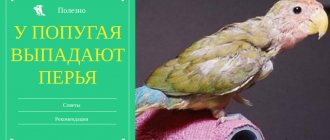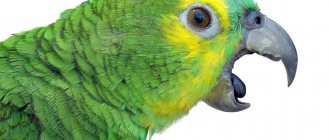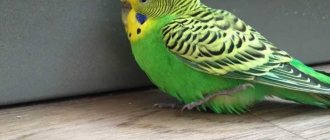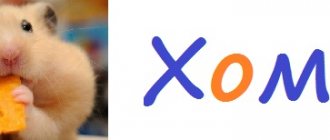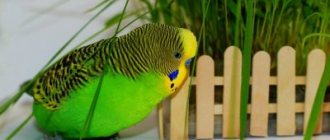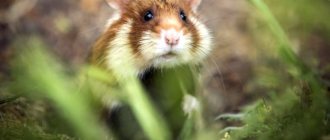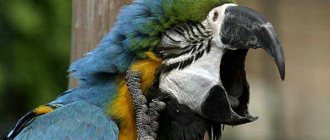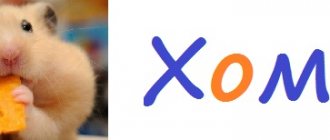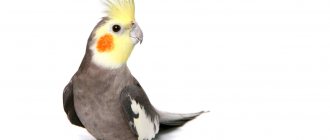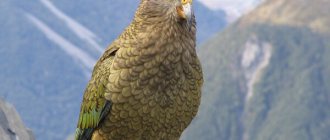Parrots are sensitive, gentle, funny, beautiful creatures. If a parrot begins to pull out feathers and lose its splendor, it means that something has gone wrong in its life, and the reason for this could be various factors. It is important to understand why a parrot plucks its feathers, what danger this poses to its health and beauty, and how to deal with this problem.
Natural causes of the disease
Molting is a natural process in birds. Juveniles may have bare areas of their body when experiencing it for the first time. In adults, baldness due to plucking does not occur.
If owners do not understand the reason why parrots pluck their feathers, it is worth paying attention to whether the bird always has the opportunity to bathe. Bathing is important for birds, as it is for most other living things. Parrots' skin is dry and, if not moisturized, becomes very itchy.
Birds engage in self-cleaning every day. After treatment, the ointment remains on the skin. “Bird tidies up” and, unable to clean “his clothes,” rips them out.
Self-plucking occurs in birds while feeding chicks.
Hygiene
Why does a parrot pluck its feathers when living in captivity? The reason is often trivial. In modern apartments, the animals' cover often dries out. Scales and itching appear, causing severe scratching, as a result of which the parrot pulls out feathers. In their natural environment, birds bathe in dew and rainwater.
In captivity, saucers, small bowls, wet lettuce leaves, and specialized bathing suits sold in pet stores are suitable as bathing containers. During the molting period, animals especially like to “take baths.”
Shedding
Tropical inhabitants shed in autumn and spring. New “clothes” begin to cut through the skin, causing itching. Parrots diligently get rid of “old clothes” and put them away. But when molting, they do not peck the skin to the point of wounds.
Symptoms of self-plucking
- The parrot sits ruffled, indifferent to everything that happens around, most often there are no feathers on the lower part of the wings, belly and chest. In especially severe cases, the entire body, with the exception of the head, becomes naked.
- Plucked feathers are bitten, torn, frayed. At first, the bird pulls out feathers during daily grooming, then does this more and more often and loses more and more feathers. If they are “alive,” bleeding may occur.
- The bird also plucks out newly growing feathers. Sometimes a parrot, frantically pulling out feathers, can also peck at the skin, then extensive wounds appear with exposed blood vessels, and bleeding begins.
Other reasons
A factor why a parrot plucks feathers may be a stressful situation. They are easily susceptible to stress - this is facilitated by changes in the environment. You should take a closer look: perhaps the cage is in a different place, a new mirror or “home” has been purchased to replace the old one, a new pet has appeared that the bird is afraid of, or the actions of small children make it worry.
Considering that these creatures are vulnerable and emotional, stress can be caused by conflicts in the family, jealousy and longing for the owner, lack of sleep, puberty, or an unsuitable partner. The cause of stress can be the loss of your “other half.”
If a bird lives alone in its house, you definitely need to purchase toys, perches, twigs, various bells, and install a mirror in its “home.” The bird will see him as a “friend” and communicate with him. Birds love to communicate, so the owner should talk and play with his pet more often, and let him fly around the room, because in their natural habitat parrots rarely sit still.
Infection
A common reason why a budgie plucks its feathers is chronic infections. In nature, predators hunt weaker animals and birds, so they “hide” diseases. It is not immediately possible to understand that a bird is sick. When a pet sits in a cage, ruffled, plucked in different places, with its eyes closed, the disease is already progressing. If urgent measures are not taken, he will die.
A common reason why a parrot itches and plucks feathers is primary infectious dermatitis. Wounds appear into which bacteria enter, causing a secondary infection.
Self-plucking is often caused by dermatitis. Dermatitis can be caused by allergies, hormonal disorders, lack of vitamins, diseases of internal organs, kidneys, and fungal diseases.
Also, the cause of self-plucking is often a serious disease - circovirus. With circovirus infection (PBVD), which disrupts the development of the feathers and skin of birds, feather plucking of the lower body region is possible. The disease affects the layer of skin epithelium, feather follicles, and lymphatic tissue.
What is the reason why a parrot plucks its chest feathers? It is there that he feels pain coming from within. You urgently need to take your pet to the “bird doctor” and check for pathologies and infections.
Parasites
The culprits why parrots pluck their feathers are parasites. With a strong immune system, the parasites living on the winged body do not cause much discomfort. But when the immune system is weakened, they actively reproduce, parasitizing the skin, beak and legs of the bird.
If there is an infestation with beetles, the animal will become restless and scratch actively. Malophages (down-eaters) are easy to detect upon examination.
Self-plucking is provoked by ticks, ixodid ticks, and gamas ticks, which parasitize feathers and cause inflammation. Inflammation is accompanied by pain and itching, but the appearance of bare areas on the body is unlikely.
Feathered creatures are susceptible to infection by numerous “pests” within the body. Giardia is often parasitic, causing the development of giardiasis. A characteristic feature is plucking under the wings. Cockatiels are the most susceptible to this.
Frustration
Frustration is the most difficult to define. Having a highly developed psyche, with strong emotional distress and lack of satisfaction, “tropical winged inhabitants” are capable of getting rid of plumage, showing aggression and depression. Typically, frustration appears due to a sudden change in living conditions and lack of usual communication. A long period in a state of frustration leads to neuroses and depression in a parrot.
Incorrect content
There are several factors that can provoke a parrot to pluck feathers:
- In nature, these bright birds live in the subtropics, and in poor lighting they can get sick.
- It is wrong to place the cage near batteries, to frequently change the location of the “home” - all this will have a detrimental effect on the physical and mental state of the bird.
- These little creatures can get sick in a cold room when they are overheated. The optimal temperature for keeping is 22-25 C.
- You cannot keep a feathered pet in its “house” all the time.
- You should not feed with the same monotonous food - birds need certain vitamins and microelements at different periods.
- A small, cramped cage with no toys will cause mental disorders in birds.
Unbalanced diet
Ornithological experts say that poor nutrition contributes to the problem. The feed needs to be balanced and should not contain a lot of sunflower seeds. Birds in captivity are unable to expend a large amount of the energy they receive. Accordingly, excess vegetable fat leads to poor health.
Lack of vitamins, minerals and amino acids, protein, especially during the breeding and molting period, leads to self-plucking. The diet must necessarily include washed, finely chopped vegetables, fruits, and herbs. Food from the table - salty, sweet, fried, fatty foods - is harmful. Forbidden and unhealthy foods cause allergies and various diseases of internal organs.
For diseases of the thyroid gland, oats and walnuts should be excluded from the diet. Instead, you should include salad, carrots, beets, and cabbage in your diet.
What to do if your parrot plucks feathers
If the owner notices that his pet is rapidly losing its plumage, it is necessary to establish the cause of this phenomenon as soon as possible. You should check whether your pet’s diet is balanced and that its living conditions are appropriate for the species. It must be remembered that a comfortable temperature for parrots is 20-25°C, air humidity is 70-80%, and the duration of daylight is 12-14 hours. Do not place the cage in a draft, near heating appliances, or in direct sunlight. Cleaning must be done daily. To prevent the bird's skin from drying out, it is provided with a bathing suit or periodically sprayed with a spray bottle.
Communication is very important for parrots. If the owner cannot pay enough attention to the pet, he should get him a friend. However, bringing in a neighbor can cause stress and make the situation worse, so it is necessary to observe the birds at first to determine whether they are suitable for each other. If acquiring a second bird is not possible, the parrot should have enough toys so that it does not get bored in the absence of its owner. In addition, the bird should be protected from stress.
If normalization of housing and feeding conditions does not eliminate the problem, the bird should be shown to a veterinarian. The cause of baldness can be infections, parasites or internal diseases, for example, pathologies of the thyroid gland. In this case, the doctor will prescribe appropriate treatment.
To prevent the bird from continuing to pluck its feathers, you can put a protective collar on it. Some owners treat the feather cover of their pets with special bitter sprays. To reduce itching, the parrot is given calcium supplements and vitamin B15. Adding iodine to the diet helps stimulate feather growth. However, you can completely cure your pet only by establishing the exact cause of self-plucking and choosing the right treatment.
Control measures
Self-medication can be harmful, since it is impossible to independently determine the true cause of plucking. The veterinarian prescribes the correct treatment.
After the examination, it is necessary to help the pet get rid of pain - for this you will need the necessary painkillers and anti-inflammatory medications. Based on the results of tests and examination, the veterinarian, depending on the cause of the disease, prescribes antiparasitic drugs or antibiotics. After treatment, the bird’s physical activity and mental balance are restored.
Previous
DiseasesAntibiotics for parrots
Next
DiseasesWhy is the parrot shaking or trembling and what to do
Treatment methods
To help your parrot not pull out its feathers, it is recommended to spray the feathers with a special bitter composition. Beafar, sold in spray form, is considered effective. The composition contains bitter components that do not harm poultry or humans.
Additionally, you can use the natural antiseptic aloe vera , which not only tastes bitter, but also anesthetizes, stops bleeding, and also softens the skin, relieving irritation.
You can use home remedies, such as making a solution from baking soda. But in addition to using these substances, it is necessary to determine the reason why the bird plucks its feathers.
How does plumage change?
Nature made sure that molting did not affect the cockatiel’s usual way of life. The flight and tail feathers begin to fall out gradually and in pairs, without depriving the parrot of the ability to fly. However, flights become more abrupt. Swiftness contributes to the rapid loss of old feathers. Small feathers covering the entire body of the bird fall out randomly.
During molting, at the bottom of the cage you can notice not only a lot of fallen feathers, but also downy dust, similar to powder. This is a special secret that is produced by the downy feathers of the cockatiel. Also, small white scales are flying from the parrot - particles from the tubes from which new feathers have emerged.
Gradually, the parrot's body becomes covered with stump tubes of growing feathers. If you carefully examine the plumage of a bird, among the formed feathers you can notice new feathers at all stages of development: from unopened to new.
While she is molting, the cockatiel is constantly itching. Sometimes he screams in pain when he touches the tube of a growing feather or strongly pulls an old one. Some pets may scream loudly and ask their owner to scratch them. Due to itchy skin, the parrot becomes restless and may show anger. He looks lethargic and drowsy - he tries to sleep as much as possible, which does not always work.
Down-eaters
The appearance of feather eaters is one of the most likely reasons why parrots pluck their feathers. Small parasites about two mm long most often infect aviary birds, but can settle on a domestic parrot if, for example, the cage was taken out onto an open balcony.
These insects have a gnawing type of mouthparts and eat feathers and keratinized epithelium. Thanks to three pairs of legs with tenacious claws, they easily move around the parrot's body.
The appearance of lice eaters is accompanied by a number of characteristic signs:
- the parrot behaves restlessly, stops playing, eats poorly;
- the bird constantly picks and tries to tear out its feathers, itches, and becomes ruffled;
- upon closer examination, the feathers are dotted with needle-like holes, and clusters of eggs are clearly visible on them.
The yellowish-brown colored insects can be found on the back and under the wings. Female lice eaters often attach their eggs to the down around the bird's cloaca.
The following drugs are used for treatment:
aerosol insecticides: “Arpalit”, “Clandestine”, “Frontline” (use with caution, following the instructions); wormwood or chamomile in powder form is rubbed into the feathers; A 1% solution of boric acid is used as an antiseptic.
The cell and all its components must be treated with disinfectants, for example, “Virosan”, “Ecocid S”. You can use boiling water or a 5% iodine solution.
Feeding porridge to adult parrots
Quote “I cook porridge (a mixture of buckwheat, rice and other grains that are on hand) and beans and corn separately in different saucepans - because... Porridge cooks quickly, but beans and corn take a long time. Yes, I almost forgot. I add a little dry oatmeal like rolled oats to the already cooked hot grains - they steam there. From the finished porridge I make pieces about the size of less than a tablespoon and place them on the kitchen board. I do the same with corn beans: I make separate piles of the same size. The board goes into the freezer. When everything has hardened, I break off pieces of porridge and legumes from the board and put them in separate dishes so that they take up less space in the freezer. This way I get pieces:
- fruits and vegetables,
- cereal porridge,
- legumes.
I defrost these pieces and feed them to the macaw. I add a dozen granules to a serving of this porridge. Why don't I mix everything at once? Because in the morning I give him mash with porridge and beans. And in the evening - more fruity. When these components are frozen separately, I can adjust the composition (although this is not necessary. You can mix everything at once). During the day I close the macaw in a cage with this porridge (for 2 hours at about 12 noon and for two hours at about 5 pm) and don’t bother it. When he began to eat it normally, he began to put the mash from the cage on the bait - now it is always available to him... But there is a danger in such mash - it must be changed to fresh no later than after 5 hours (it spoils quickly). - “Quote closed”
How to distinguish a bird's self-plucking from its infestation by ectoparasites?
Pere-eaters
Self-nurturing of birds is never associated with feather eaters. In the presence of feather eaters, the bird may become restless, itch, and often clean its plumage, but malophages (down feather eaters) do not lead to the appearance of bare areas of the bird’s body. Bird eaters are always visible to the naked eye, and even more so with a magnifying glass.
Tick mites (Syringophilus spp.)
These mites can cause self-plucking because... The feather mites infect the developing feathers and cause a widespread inflammatory reaction. And the inflammatory reaction is always accompanied by pain. When a bird is infected with a feather mite, the development of the feather is disrupted: the feather is curved, underdeveloped, mainly the flight feathers are affected, bare areas of the bird’s body appear very rarely.
Ixodid ticks
When infected, birds may self-pluck. But more often, when a bird is massively infested with ixodid ticks, the bird does not have the physical strength to pull out the plumage. Ixodid ticks are clearly visible to the naked eye.
Eye diseases
If your pet was completely healthy, but suddenly began to blink or close his eyes frequently, try to examine his eyes closely
Pay special attention to the absence of foreign bodies: husks, sand, fluff
The speck from the eye must be removed by carefully running a clean cotton pad over the surface of the eyeball
It is quite easy to suspect inflammation: if the cockatiel parrot usually has clean and shiny eyes, then during illness they become cloudy and tears flow. The area of skin around the eyes turns red and pus is released.
Depression
Another common reason why parrots pluck feathers is basic depression.
Domesticated parrots are often purchased not only because of their magnificent appearance, but also because of their funny behavior and cheerful disposition.
These birds can have fun all day long and fly around the room, attracting your attention and responding to your reciprocity
However, as soon as you stop paying attention to them, they will immediately begin to feel sad. Surely you could see a picture more than once when a lonely bird retires into its cage and constantly dozes
However, other factors can also cause depression. Such as the death of a couple, change of place of residence, chronic lack of sleep, and even food that is unsuitable for the pet. All of this can cause your parrot to start itching and tearing out its feathers.
And if a caring owner immediately pays attention to this, he will certainly correct the current situation. An experienced breeder will not even need to explain what to do and what to do if his pet becomes depressed
Be sure to place some interesting toys near the bird’s house and inside it that the pet could play with in your absence. In addition, you will need to check the poultry feed and, if necessary, replace it with another grain composition.
Knemidocoptic mange (scabies)
This is an extremely dangerous disease that is caused by the scabies mite, a microscopic yellowish-white parasite about 0.3 mm in size. Untimely cleaning of the cage and even dust in the apartment can cause infection with knemidocoptic mange. Accessories purchased at a pet store can be infected with scabies mites or a green twig brought from the street.
Using a gnawing-sucking type of mouthparts, the parasites make passages in the skin of the bird, where they feed on blood and actively reproduce. They affect both bare areas of the body - paws, cere and areas around the eyes, as well as feathered areas. The reason why a budgerigar plucks its feathers is severe itching, which is caused not so much by the movement of parasites as by an allergic reaction to the products of their vital activity.
The symptoms of knemidocoptosis are difficult to confuse with signs of other diseases:
- the horny scales on the paws and cere become deformed and become covered with lumpy growths;
- the bird becomes extremely restless, itches, scratches itchy places with its beak;
- Spongy spots and cracks appear on the surface of the beak.
A parrot in this condition needs complex treatment developed by a specialist. A veterinary ornithologist may prescribe lubricating the affected areas of the body with birch tar, aversectin ointment, the drug “ASD-3”, diluted with vegetable oil in a ratio of 1:5. Frontline insecticidal spray can also be used.
Diagnostics and therapy
Why does my budgie's feathers fall out? A similar phenomenon can occur not only in this breed. The presence of the disease can only be diagnosed in a veterinary clinic. In this case, the veterinarian can determine the presence of an allergic reaction, hormonal imbalance, bacterial disease, fungus, deficiency of nutrients and vitamins. Before visiting a specialist, a bird owner should:
- Watch the parrot carefully.
- Examine its plumage and body.
- Make your pet's diet balanced.
If there are several parrots in the house, then the sick individual must be separated from the rest. Healthy birds also need to be closely monitored and well fed.
Dermatitis
At the moments when your tamed pets pluck their feathers and scratch their skin until they bleed, they can catch some disease that significantly complicates an already difficult situation.
Many factors can cause this condition. Such as lack of vitamins, dry air, etc.
If your pet finds itself in such an unpleasant situation, it cannot do without timely help from specialists. So don't delay your trip to the vet. Surely he will immediately advise you to do a series of tests on your domesticated parrot.
Tags
budgie plucking why does a parrot plucking budgie so much if a parrot plucks budgies relates molting parrots groom budgie a lot When a parrot plucks a budgie plucks budgies the most budgies so budgies the most budgies can budgies need budgie budgerigars are more active too
wavy corellasymptomstypesof ownersinfectiontotallargemost
Building material in nests
This is the first thing that comes to mind. The basic instinct is reproduction. You need a place where the eggs will hatch and the chicks will live for the first time.
- Madagascar Greyhead.
- Green-headed (collared).
- Spectacled.
- Taranta (black-winged).
- Orangehead.
- Rosy-cheeked.
- Masked.
Collecting material to create a nest The masked lovebird has three subspecies:
Not all species build nests; some make do with a hollow in a tree. Some people are too lazy to look for a hollow; the bird makes its bedding right on the ground.
The nest is built by the female (gender discrimination...). In nature, the bird finds suitable twigs, blades of grass, leaves and drags them to the site of the future nest. Birds don’t have bags, so they have to insert “building materials” into the tail, into the feathers on the lower back. The hubby (future father of the family) more often interferes with the working female, hovering around, and some completely unreasonable ones try to pull the “decoration” out of the chosen one’s tail. Female spectacled lovebirds in nature and in captivity carry blades of grass or twigs in their beaks when building a nest.
Attracting a partner
Fleas
In nature, bird fleas settle in the nests of birds during incubation. Jumping, tenacious and fertile parasites can enter an apartment on shoes or through ventilation, but in order to take root and reach the parrot, they need certain conditions: a lot of dust and rare cleaning of the cage in which debris accumulates.
The danger of fleas lies not only in painful bites, but in the possible infection of the bird with infections that these insects carry, for example, tularemia.
A pet bitten by fleas behaves restlessly both day and night, this becomes one of the reasons why a parrot plucks feathers on its chest and other places. Brown parasites with a flat body, two to eight mm long, can be detected when inspecting the litter. Eggs are more difficult to find: females spray them in small portions in all directions, which ensures successful distribution throughout the room.
Red tick
Parasites enter the parrot's cage with contaminated sand, loose food, and from street birds. During the day they hide at the bottom of the tray, and at night they move onto the body of the owner, and tick bites become the reason why parrots pluck out their feathers. It is difficult to see the insect with the naked eye. Its length is about one mm, however, after being pumped with blood, it becomes twice as large and acquires a characteristic red color.
The first symptom of infection is the parrot's restlessness at night, and a pronounced sign is the bird's severe weakening as a result of blood loss.
Effective treatment methods for red mite infestation:
